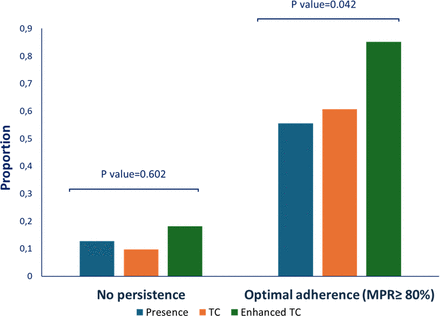Discussion
In this prospective study, the employment of TC did not provide any advantage as compared with traditional in presence visits in terms of adherence to alendronate in patients with osteoporosis. Significant improvement in medication adherence was achieved, instead, by providing patients with the possibility to contact on-demand their bone specialists during the follow-up. Moreover, the on-demand use of email was sufficient to compensate for the perceived decrease in quality of care linked to the service modality as assessed by PREMs questionnaires. No impact was detected on the group of non-persistent patients who either never started therapy or discontinued it immediately.
Non-adherence to prescribed medications is a frequent phenomenon in real-life clinical practice in osteoporosis, with significant health and economic consequences.4 In agreement with previous reports,30 about 50% of the study patients with an indication to start treatment with bisphosphonates18 and followed-up by standard care either did not start the prescribed treatment or showed suboptimal adherence to the drug during the first 12 months of follow-up. Noteworthy, in our study, the suboptimal adherence to alendronate tended to be associated with BMD values outside of the range of osteoporosis values, likely leading patients to have inaccurate and diminished perception of their risk of fracture.31
The chronic care model suggests that the way the interaction between the healthcare system and chronic patients is structured, its continuity in time, and as the capacity to empower patients in the self-management of their conditions are all fundamental aspects to guarantee optimal health outcomes.32 Improvement in patient–physician interaction might also be a critical aspect to increase adherence to medications in chronic patients.33 Patients with osteoporosis who interact effectively with bone specialists to establish and maintain adherence to medication have been shown to display fewer concerns about medications and to be able to overcome certain barriers to adherence which could defeat others.34
A chronic care model supported by telemedicine has been suggested as a possible strategy for improving medical adherence to anti-osteoporotic drugs, as it favours regular clinical checks,31 avoids the need for time-consuming visits to the bone clinic or ambulatory and possibly reduces patients’ anxiety and depression.35 However, in agreement with previous experiences,36 37 in our study, telemedicine itself did not show any advantage as compared with the standard care with respect to medication adherence, likely because both service modalities guaranteed similar frequency of clinical checks during follow-up. These results suggest that further educational and/or on-demand services in addition to traditional or telemedicine consultation are needed to ensure adequate adherence to osteoporosis treatments. Indeed, one could argue that the average 15 min visit regardless of the service modality was not long enough for patients to talk to their bone specialists about all their problems and for bone specialists to satisfactorily address all patient concerns during the limited time frame. Patients may want proof or evidence of effectiveness through more structured monitoring, and they may be discouraged to either starting or continuing treatment in the absence of evidence of perceived effectiveness.38
In this context, we showed that when patients were given the opportunity to combine TC with the possibility to contact the bone specialist on demand, this brought about a significant improvement in adherence to medication. It is likely that when the email was used, patients turned out to be adherent to drug treatment as they received clarifications on doubts and beliefs concerning the prescribed treatment. Interestingly, adherence to alendronate was optimal even in those patients who did not use the email for contacting the bone specialists, likely reflecting an effect of this service modality on reducing anxiety and concerns of the patients.35
The favourable effects of enhanced telemedicine occurred even if patients had at baseline the perception of having just a mild condition, as suggested by their high levels of perceived QoL in terms of symptoms and physical function. Interestingly, patients in follow-up with enhanced TC showed fewer concerns about the TC service modality, suggesting that the combination with email use was sufficient to compensate for the perceived decrease in quality of care linked to TC.
This study has some limitations. First, since non-persistent patients were lost to the follow-up and PREMs data were not available for this subgroup, we were not able to evaluate all the determinants of non-persistence to medical therapy. Second, Morisky questionnaire, that is based on self-reported data, may not be the most appropriate questionnaire to assess medication adherence.39 However, along with the Morisky score we also evaluated the MPR and the rate of optimal adherence in our patients was in line with previous observations performed by more reliable methods.30 We used a simple and non-standardised tool, that is, email, for guaranteeing patient–physician interaction. Email, though, might not be feasible in real-life clinical practice when thousands of patients are followed-up in referral centres. Future studies are needed to clarify whether the use of other tools, such as ad hoc developed apps40 or chatbots,41 might be more effective than emails for supporting patients with osteoporosis in the adherence to treatment with bone-active drugs. Moreover, the 12-month follow-up did not allow us to assess the long-term impact of enhanced telemedicine on adherence to oral bisphosphonates. Indeed, a recent study suggested that the TC service modality might be experienced as of lower quality over time.29 Finally, the small size of study groups did not allow us to assess all the confounding factors potentially influencing adherence to anti-osteoporotic therapy. However, the enrolment of patients in a single centre and the use of a single drug (ie, branded alendronate) might have guaranteed some homogeneity across study groups,42 although patients receiving standard in presence care were more frequently older and with more comorbidities as compared with those followed-up by telemedicine. When we accounted for these differences, the magnitude of association between enhanced TC and adherence was reduced, but the statistical significance remained unchanged. This suggests that the observed differences in adherence between groups were not solely attributable to patients’ age or comorbidities. It is possible, however, that other unmeasured patient characteristics differed between groups, that we did not observe. For example, older patients with a higher burden of comorbidities are likely to be frail and at greater risk of poor adherence to several treatments.43 44 Our study provided preliminary evidence that enhanced TC may improve adherence to alendronate even in subjects with high burden of comorbidities, potentially frail. This result might be clinically relevant since frail patients are theoretically the best candidates for telemedicine coupled with email due to their difficulties in presenting to a face-to-face visit. Unfortunately, the other side of the medal is that they are often limited by low IT skills, such as in our study, thus being highly discriminated against the access to high quality health management. Interestingly, a previous retrospective study on acceptability of TC among patients with osteoporosis found that lack of social support (ie, caregiving) with using the TC platform was not correlated with a lower acceptability of TC.29 Future studies should build on the evidence produced in this research and clarify the role of caregivers in favouring the access of frail and aged patients with osteoporosis to telemedicine services.
Notwithstanding the limitations, this prospective study confirms the importance of patients’ perceptions of quality of the care received for optimal adherence to medication and suggests that enhanced telemedicine may provide a valuable tool for educating and supporting patients during the follow-up after drug prescription.





